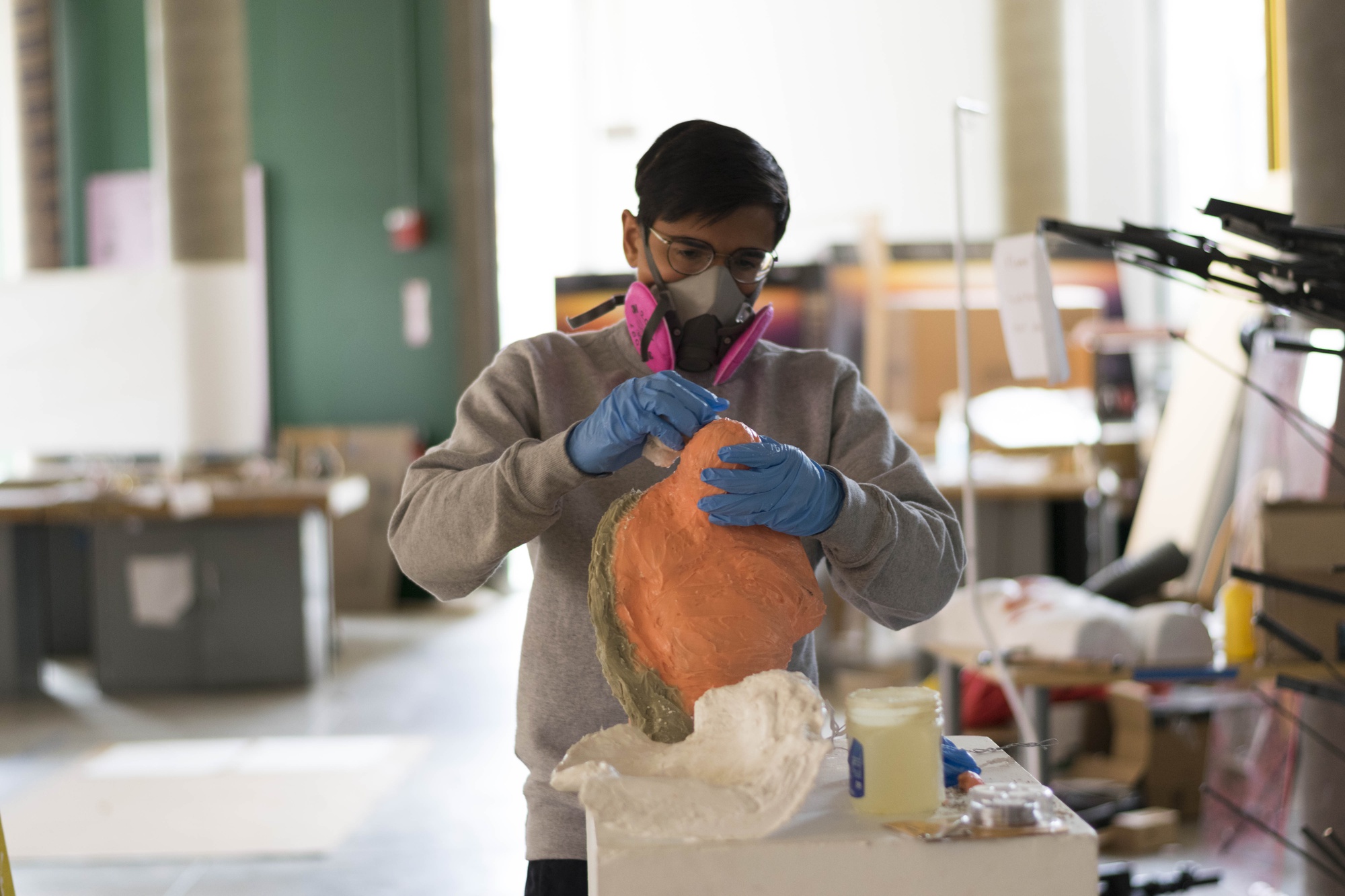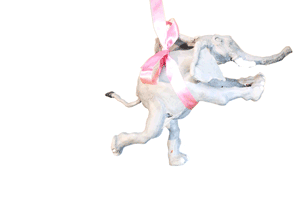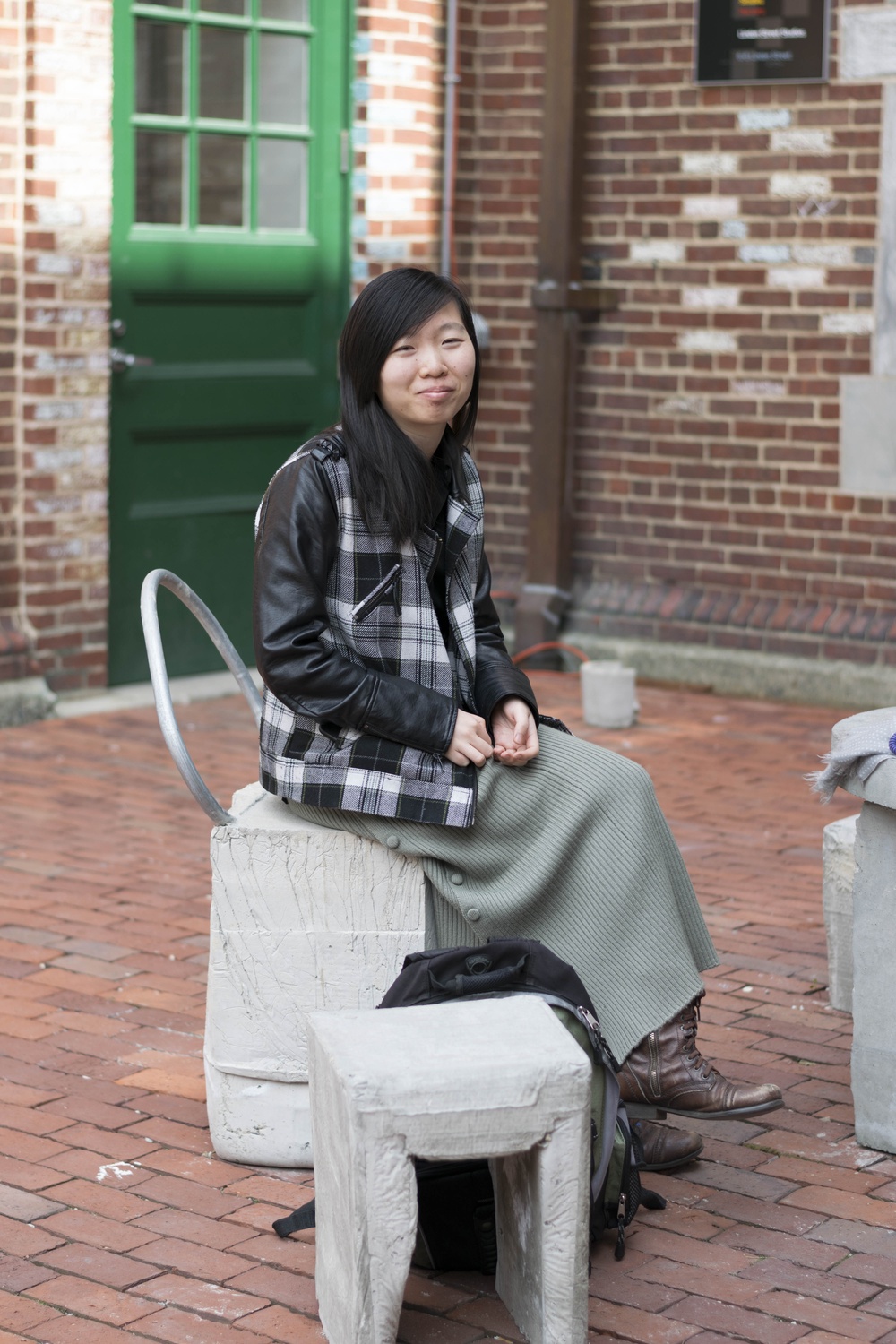
'A Moving Target'
By Rick Li, Crimson Staff WriterAlison B. Reed ’17, a Visual and Environmental Studies concentrator, was working on her senior thesis when she decided something didn’t feel quite right. “I was just looking at the labels.” she recalls. “I think I may have joked with my advisor that I’m terrified of all my materials.”

Her project seemed to be relatively benign: A stop-motion movie about an elephant. As both the director and set designer, she hoped to construct a puppet protagonist out of foam latex via a process she found on YouTube. The materials she used were familiar, like household objects: latex, silicone, dish soap, vaseline, oil. The construction of the puppet, however, was a bit more involved.
The first hiccup was the oven. “You needed an oven—an outdoor oven,” Reed says. “You were supposed to be doing part of this process outside.” Procuring this open-air oven like the tutorial suggested was a journey. After getting rejected by Harvard’s ceramics studio due to concerns about fumes, deliberating with the nearby Massachusetts College of Art and Design, and meeting with some graduate students in the chemistry department, she decided to abandon the foam latex for silicone.
Switching media wasn’t the end of her concerns. “I ended up bringing it back to my dorm room and I would spray [silicone] outside of my dorm," Reed says. “By the end of winter break, my dorm smelled very much like this spray, which really scared me.” According to Reed, someone had a physical reaction to it after doing a thesis review in a room it was later stored in, and a professor in one of Reed’s later reviews characterized the smell as toxic.
Safety is always a moving target. What's considered safe changes all the time.
Reed’s elephant’s narrative came together by the end of the semester. A year out from its completion, Reed has had ample time to reflect about the role of safety in her creative process.
“I think it’s because safety is always a moving target," she says. “What’s considered safe changes all the time.”

The concept of safety shares an interesting relationship with the artmaking process, a discipline which often values the unconventional and groundbreaking. Navigating this balance has been a key consideration of students and faculty, with regards to both the larger art world and the more insular community at Harvard.
A Material World
As beautiful as the final products can be, working with various artistic media comes with a set of risks. And while the danger associated with performative pieces and heavy machinery might be obvious, other potential dangers are far less apparent.
Paints, especially oil paints, are popular in artmaking. A staple of arts curricula around the country, many are risky for the same reasons they’re colorful: Neurotoxic heavy metals are often responsible for producing the different hues.

“There are a set of paints that can only achieve that kind of color using cadmium and cobalt—heavy metals. They all say it on the paint tube,” former VES concentrator Michael C. Kennedy-Yoon ’17 says. “We were always aware of that.”
The health hazards of these metals are well documented with regards to industrial work. Though less information is known about their effects at the lower concentrations present in common paints, growing concern has caused manufacturers to begin placing relevant information on labels and shift towards synthetic—though potentially just as questionable—alternatives.
“The big danger in oil painting class was actually the flammable materials which we use for our solvent,” Kennedy-Yoon says. One substance commonly cited in these conversations as a necessary evil is the well-identified carcinogen formaldehyde, used to mix with oil paints. While proper disposal of the solvent significantly reduces the risk of fire, other health hazards related to exposure are more difficult to contain.
Artists in different disciplines face a whole different set of concerns. Resin, popular among modern sculptors, is a harsh irritant. It’s rumored to have contributed to the untimely death of Eva Hesse, an experimental artist prolific in the mid-20th century.
Other sculptural materials are less insidious but still worthy of caution. Eriko M. I. Kay ’16, a current TA and former VES concentrator who worked extensively with concrete, says, “I didn’t realize how heavy my sculptures would be. I ended up having a bunch of 50-pound sculptures at the end of the year that I didn’t know how to move by myself.”
A quick Google search pulls up dozens more risks that come with art. For example, toluene, a component of spray paint, is known to harm the central nervous system. And while the federal government responded to these findings by passing the Labeling of Hazardous Art Materials Act (LHAMA) in 1990, which mandates federal oversight, the exact chemicals going into art media today are ever-changing.
It is no surprise, then, that Harvard’s own VES department keeps access to these chemicals on a tight leash. Students are encouraged to utilize University resources, but they must first enroll in a related class and work through training procedures. Thesis students trying to get ahold of their own materials must fill out a reimbursement form, and while the 2017 form does not explicitly mention safety, the request must be submitted to and cleared by department staff.
Prohibiting certain materials, however, might restrict students’ abilities to effectively express themselves. Instead, the front lines of material safety at Harvard exist in the classroom, where risk awareness and mitigation are skills being integrated into the curriculum.
Hands On and Off
“Perhaps a certain group of individuals in the art world more broadly has a kind of tendency towards disregard for one’s health and body. You know, you just have to go to New York to see all the art kids smoking,” VES concentrator Ariana L. Chaivaranon ’18 says.
She is quick, however, to divorce that observation from her experiences with the University. “I don’t think that’s necessarily a problem that has anything to do with the faculty or the classes in the department. I think that’s more about the culture of art-making more broadly as intertwined, historically, with counterculture movements and those movements’ interests in resistance and alternative ways of living.”
VES, Harvard’s resident art department, walks a fine line between providing students appropriate guidance to manage safety and ample space for independent work.

“VES is the only concentration at Harvard where you make things with your hands,” Paula Soares, Manager of Academic Programs, says.
As one supervisor of curricular art-making on campus, the VES department keeps a close eye on risk. At just around 80 concentrators, it is a moderately sized department with famously small classes. Within this sampling of students, there is a wide range of experience: Some enter college having already compiled award-winning portfolios, while others come into the department with hardly anything at all. “I don’t think I got anywhere beyond Crayola,” Reed jokes.
VES, like many other departments, has a sophomore tutorial for building foundational skills. According to Matt Saunders ’97, the assistant professor who leads the class, the course provides students exposure to faculty members, canonical readings, and safety techniques. The result is the bedrock upon which future projects can flourish.

And though the course is fairly new and a work in progress, the class has received a warm response from several students. “It’s a chance to get to the other people in the department, and we experiment with a lot of different media,” VES concentrator Memie H. Osuga ’20 says.
Despite a focus on safety, the department still encourages academic and creative freedom. By the time they get to their senior year, many students opt to take on a senior thesis, an independent art project which is monitored by an advisor and three reviewers.
“We definitely encourage experimentalism in the arts here,” Soares says. This promise, however, is not without caveats. “If something isn’t really consistent with what the student has worked in up to that point, it might be a red flag.”
The question of where to step in and where to step away has been an interesting question for the department. Some students take pride in challenging the norm and toying with the ensuing pushback. “I sort of went a little bit off the grid. I’m working on a project that no one else has done before in terms of medium or concept,” VES concentrator Essa Li ’19 says. Unlike her counterparts, Li has chosen to structure her thesis around exhibitions, running a space called the Vessel Gallery.
Some are content with an increased amount of space more detached from constant oversight. “Honestly, I kind of like the VES method of ‘Go do stuff, and we’ll talk about it later,’” VES concentrator and thesis student Kevin Zhu ’18 says.
A Space of One's own
“For every hour you spend in class, I spent an hour or two outside of class,” Kennedy-Yoon says.
Art-making is a long, labor-intensive process, and classroom instruction is only the tip of the iceberg. The majority of the effort put towards creating a piece is developed independently.
Thesis concentrators are afforded a space outside of the classroom in the form of Linden Studios. Perhaps fittingly, Linden’s history is a curious one suited to a creative center: Originally a set of squash courts, the building has since been re-outfitted into a studio space.
Today, the building boasts large rooms divided by partial walls and occupied by several students each. The tall, white walls are illuminated with ample lighting, and the shared air space blankets Linden beneath a quiet cover of conversation. Each room houses an assemblage of art supplies: Metalwork, canvases, and fabrics line the floor and walls. A flammable solution disposal container sits in the corner.

To a first-time visitor, the atmosphere is strikingly casual. And maybe that’s part of the point. “If I were to look on Linden and maybe some of the practices in VES, I might be concerned because of the inherent safety risks involved,” VES concentrator Susan Li ’18 says.
“The sort of freedom we get here is really important. It’s different from everywhere else on campus,” she says. “I think it’s necessary to have some degree of freedom in order to push the boundaries of art. You can’t make anything in a tiny box where you’re not allowed to touch any tools.”
Red, laminated safety guidelines are placed on the exits to the building. Each reads: “Security for yourself and others depends solely on each occupant.”
A Tale of Discretion
The issue of safety exists on a spectrum.
Some of the most dangerous pieces of machinery are located in the wood and metal shops, which are staffed by monitors. Students planning on using the facilities must undergo extensive training procedures. Even then, time spent at machines is minimized. According to Zhu, “You just learn the fabrication you need. You will usually go to the wood shop when you have an idea in mind.”

The protocols associated with various forms of media, however, are largely governed by the decisions of the professors who are most familiar with them.
Teaching fellows, too, are also valuable in this teaching process. Kay details some of the procedures she takes into account during her oil painting workshop. “A lot of the materials are much better than they used to be. They’re really not toxic in the ways we’re using them, but they do have smells that people can be sensitive to. So knowing to use masks and leave the windows open or find spaces in the room with ventilation is better.”
All things considered, much of the responsibility ultimately falls on the people actually doing the work. “Art-making often involves a kind of risk with materials because you’re using physical materials that have the potential to push back against you,” Chaivaranon says. Still, as in the case with her intaglio printing class, the department has always been careful to point out risks such as acid. “Artists should be aware of the materials in their surroundings and how their actions affect the materials.”
But even the development of a conscientious practice is not exempt from human error. Reed remembers moments when students working with resin were using inadequate gas masks to protect themselves. These lapses in judgment are not unheard of.

“If you’re working with things that have fumes, there is an open-air area that you’re supposed to go to. Not everyone does, and I find that very frustrating,” Kennedy-Yoon says. He recounts a story of when a student left open a bottle of acetone, causing the whole room to smell like the chemical and forcing an evacuation.
“It’s the sort of thing you’d never do in front of the teacher,” Kennedy-Yoon says.
Under Control
In spite of potential dangers in the materials he has worked with, Kennedy-Yoon affirms his positive experience with the university as a nurturing space. “I am grateful that VES was a very positive and safe place for me in a college that did not always feel super welcoming or supportive,” he says.
This sentiment is echoed by the department’s administrators. “Nothing’s worth getting hurt or sick. That doesn’t mean you can’t do great work. And there is work out there, once you get out to do whatever you want,” VES Chair Robb Moss says.
Though influenced by the larger art world, Harvard’s VES department prides itself on providing a protected environment for burgeoning artists to learn. Physical safety is a well-established priority, but certain types of other risk are actually encouraged. Saunders draws a distinction between physical and creative risk, the latter of which is promoted in the classroom and in similar learning spaces.
“I don’t want people taking physical risks in the class, but I want people taking conceptual risks or doing things that might fail," he says. “An ambitiously conceived, rigorous project that doesn’t generate a great outcome—if the painting is a muddy mess at the end—that to me is still a successful art project.”
I don't want people taking physical risks in the class, but I want people taking conceptual risks or doing things that might fail.
This emphasis on support may be emblematic of the atmosphere of the post-university world today. “I was here in the late ’90s, in a time of American confidence. The Cold War had just ended, the economy was booming,” Saunders says. “I don’t see that sense of safety in your generation right now. People seem a lot more anxious than I remember being. The world is a lot more anxious.”
This enclave of arts at Harvard today exists as a space that both deliberately exposes students to and shelters students from risk in the world around them.

“The connection between pushing the envelope and safety is a very tricky one to think about in a position of responsibility,” Saunders says. “And if anything, I’d like to err towards safety now.”
—Staff writer Rick Li can be reached at rick.li@thecrimson.com.
